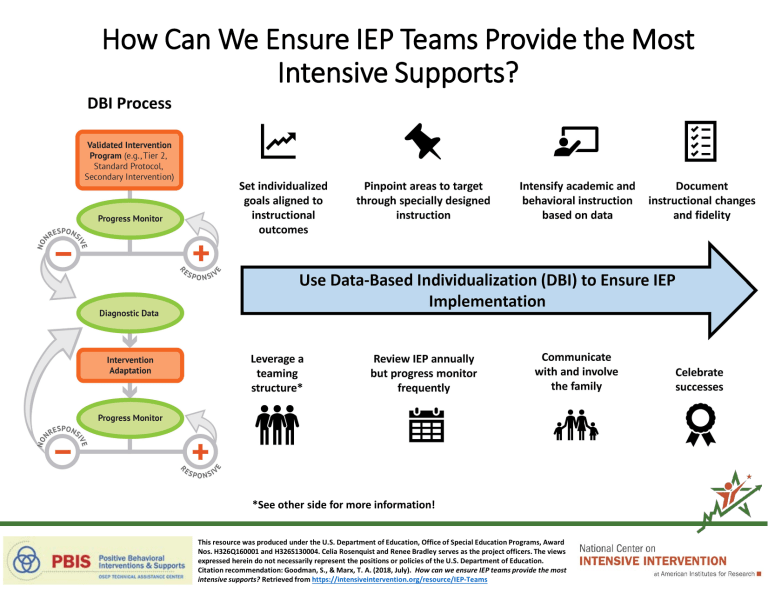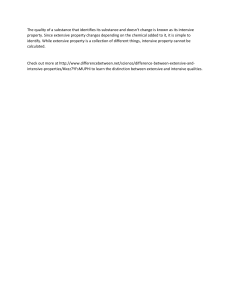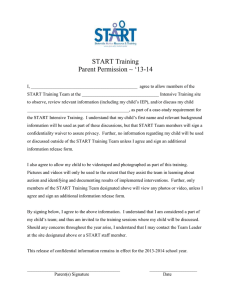
How Can We Ensure IEP Teams Provide the Most Intensive Supports? *See other side for more information! This resource was produced under the U.S. Department of Education, Office of Special Education Programs, Award Nos. H326Q160001 and H326S130004. Celia Rosenquist and Renee Bradley serves as the project officers. The views expressed herein do not necessarily represent the positions or policies of the U.S. Department of Education. Citation recommendation: Goodman, S., & Marx, T. A. (2018, July). How can we ensure IEP teams provide the most intensive supports? Retrieved from https://intensiveintervention.org/resource/IEP-Teams Teaming Structures Across the Tiers Blank Key Questions Schoolwide (Core/Tier 1) Is the core programming meeting the academic or behavioral needs of most students (e.g., 80% of students)? Relevance to Data-Based Individualization Team Membership School/building leadership team, with subcommittees focused on academics and behavior (as needed) X Targeted (Tier 2) Are the targeted supports meeting the academic or behavioral needs of students receiving targeted interventions? Intensive (Tier 3) Are the intensive supports meeting the academic or behavioral needs of students with intensive needs? Individualized Education Program (IEP) Team Are the special education supports and services appropriate and meeting academic or behavioral needs of students with IEPs? Grade-level or problem-solving teams with representatives from school leadership team subcommittees (as needed) Student-level team with representatives from problemsolving teams, and personnel with content and data analysis expertise Similar to intensive support team, with additional members required by IDEA for a multidisciplinary team Determine special education eligibility, develop an IEP aligned with an intensive support plan, monitor the effectiveness of Intensive programming, and evaluate progress toward IEP goals Use data from Tiers 1–3 with requirements for special education eligibility and programming (e.g., psychoeducational assessments, speech/language assessments, medical assessments and diagnoses) X Roles and Responsibilities Develop plan, support implementation, and monitor the effectiveness of Core/Tier 1 programming Develop plan, support implementation, and monitor the effectiveness of Targeted/Tier 2 programming Develop plan, support implementation, and monitor the effectiveness of Intensive/Tier 3 programming Data Sources Benchmark/universal screening assessments, district assessments, state assessments, discipline referrals Benchmark/universal screening assessments, progress monitoring measures, behavior “point sheets,” discipline referrals Academic diagnostic assessments, functional behavior assessment, individual student data across academics and behavior (e.g., work samples, anecdotal or observational data) Frequency of Data Collection/Data Review Academics and behavior: Three times per year Academics: One or more times per month Academics: One or more times per week Behavior: One or more times per week Behavior: One or more times per day Progress may use data collected in various tiers of support or may be specific to IEP goals; IEP must be reviewed at least annually Taxonomy of Intervention Intensity: Academics The Taxonomy of Intervention Intensity* was developed based on existing research to support educators in evaluating and building intervention intensity. Dimensions* Description Strength How well the program works for students with intensive intervention needs, expressed in terms of effect sizes. Effect sizes of above .25 indicate an intervention has value in improving outcomes. Effect sizes of 0.35 to 0.40 are moderate; effect sizes of 0.50 or larger are strong (preferred). Dosage The number of opportunities a student has to respond and receive corrective feedback. It refers to the size of the instructional group, the number of minutes each session lasts, and the number of sessions provided per week. Alignment How well the program (a) addresses the target student’s full set of academic skill deficits, (b) does not address skills the target student has already mastered (extraneous skills for that student), and (c) incorporates a meaningful focus on gradeappropriate curricular standards. Attention to transfer The extent to which an intervention is designed to help students (a) transfer the skills they learn to other formats and contexts and (b) realize connections between mastered and related skills. Comprehensiveness The number of explicit instruction principles the intervention incorporates (e.g., providing explanations in simple, direct language; modeling efficient solution strategies instead of expecting students to discover strategies on their own; providing practice so students use the strategies to generate many correct responses; and incorporating systematic cumulative review). Behavioral support The extent to which the program incorporates (a) self-regulation and executive function components and (b) behavioral principles to minimize nonproductive behavior. Individualization A validated, data-based process for individualizing intervention, in which the educator systematically adjusts the intervention over time, in response to ongoing progress monitoring data, to address the student’s complex learning needs. *Fuchs, L.S, Fuchs, D. & Malone, A.S. (2017). The Taxonomy of Intervention Intensity. TEACHING Exceptional Children, 50(1), 35–43. This document was developed under U.S. Department of Education, Office of Special Education Programs (OSEP) Grant No. HH326Q160001. Celia Rosenquist is the OSEP project officer. The views expressed herein do not necessarily represent the positions or policies of the U.S. Department of Education. WANT TO LEARN MORE? WANT TO LEARN MORE? Visit us at www.intensiveintervention.org. Taxonomy of Intervention Intensity: Behavior The Taxonomy of Intervention Intensity* was developed based on existing research to support educators in evaluating and building intervention intensity. Dimensions* Description Strength How well the program works for students with intensive intervention needs, sometimes expressed as a promising or effective program by a reliable source (e.g., NCII Tools Charts, WWC). Dosage The number of opportunities a student has to (a) respond (i.e., practice/demonstrate skill), (b) receive positive feedback (e.g., praise, tokens, points), (c) exchange for backup reinforcers, and (d) receive corrective feedback. Alignment How well the program (a) addresses school-wide expectations, (b) addresses classroom/teacher expectations, (c) addresses student’s skill deficits, (d) matches rewards to student’s preferences and/or function of problem behavior, and (e) does not address extraneous skills. Attention to transfer The extent to which an intervention emphasizes how and when a student uses skills across contexts/situations and includes opportunities to practice using skills across context/situations. The program reinforces the use of skills across contexts/situations. Comprehensiveness The extent to which the intervention includes a plan for (a) teaching appropriate behavior, (b) adjusting antecedent conditions to prevent problem behavior, (c) reinforcing appropriate behavior, (d) minimizing reinforcement for problem behavior, (e) fading supports (and supports can be easily faded), (f) monitoring fidelity, (g) working in conjunction with related services, and (h) communicating with parents. Academic support The extent to which the program (a) can be easily integrated within context of academic instruction, (b) complements rather than supplants academic focus, and (c) includes procedures for reinforcing responses related to academic achievement (e.g., engagement, work completion). Individualization A validated, data-based process for individualizing intervention, in which the educator systematically adjusts the intervention over time, in response to ongoing progress monitoring, to address the student’s complex learning needs. *Adapted from Fuchs, L.S, Fuchs, D. & Malone, A.S. (2017). The Taxonomy of Intervention Intensity. TEACHING Exceptional Children, 50(1), 35–43. WANT TO LEARN MORE? WANT TO LEARN MORE? Visit us at www.intensiveintervention.org. Considerations for Effective Implementation 5 Elements of Fidelity Student Engagement Adherence How attentive and involved are the students in this intervention or activity? Is there evidence that the intervention was delivered as intended? How well do we stick to the plan, curriculum, or assessment? Are the intervention and assessment delivered consistently across different teachers and settings? Program Specificity How well is the intervention defined and different from other interventions? Quality of Delivery Does the interventionist have the necessary training, knowledge, and skills to deliver the intervention correctly? How well is the intervention, assessment, or instruction delivered? Are quality teaching practices used consistently and with appropriate intensity across all sessions or interventionists? Exposure/Duration Does the schedule allow the intervention to be delivered for the recommended dosage (duration and frequency)? How often does a student receive an intervention? How long does it last? Is the student regularly attending school? Is the teacher regularly available to support instruction? Did any factors prevent the student from receiving the intervention as intended? Why fidelity? If we don’t implement critical components of an intervention with consistency, we cannot link student outcomes to the instruction provided. Fidelity can help us to determine the effectiveness of an intervention, and identify if a student requires more intensive supports. Source: Dane and Schneider (1998); Gresham, Gansle, and Noell (1993); O'Donnell (2008). References Dane, A. V., & Schneider, B. H. (1998). Program integrity in primary and early secondary prevention: Are implementation effects out of control? Clinical Psychology Review, 18, 23–45. Gresham, F. M., Gansle, K. A., & Noell, G. H. (1993). Treatment integrity in applied behavior analysis with children. Journal of Applied Behavior Analysis, 26, 257–263. O’Donnell, C. L. (2008). Defining, conceptualizing, and measuring fidelity of implementation and its relationship to outcomes in K–12 curriculum intervention research. Review of Educational Research, 78, 33–84. This document was produced under the U.S. Department of Education, Office of Special Education Programs, Award No. H326Q160001. Celia Rosenquist serves as the project officer. The views expressed herein do not necessarily represent the positions or policies of the U.S. Department of Education. No official endorsement by the U.S. Department of Education of any product, commodity, service, or enterprise mentioned in this document is intended or should be inferred. Find additional information at www.intensiveintervention.org. Breaking Down the DBI Process Questions & Considerations Data-based individualization (DBI) is a research-based process for individualizing and intensifying interventions for students with severe and persistent learning and behavioral needs. The process integrates evidence-based intervention, assessment, and strategies using 5 interactive steps: STEP 1 | Validated Intervention Program: The Foundation The DBI process builds on an evidence-based and standardized intervention delivered with fidelity. At this step, teachers consider: Does the intervention target the student’s academic and behavioral needs? Is the intervention based on the best available evidence? Does the intervention align with core instruction? Has the intervention been shown to work with most students? Are procedures in place to ensure the intervention is delivered as planned? STEP 2 | Progress Monitor: Did the Intervention Work? At this step, staff regularly collect and analyze progress monitoring data to determine if the student is responding to the validated intervention. Teachers consider: Does the tool meet technical standards for progress monitoring and match the desired academic or behavioral outcome? Were data collected regularly and with a consistent approach? ANALYZING DATA Were progress data graphed? Was the goal set using a validated approach? Was the intervention effective for most students? Do data indicate that the intervention is working? – If no, move to Step 3. + If yes, move back to Step 1 and continue to provide the validated intervention and monitor progress. STEP 3 | Diagnostic Data: Why Didn’t the Intervention Work? At this step, staff use diagnostic data to develop a hypothesis about why the student is struggling. Teachers consider: Do multiple data sources confirm slow progress? What do these data suggest about what needs to changed? Have both academic and behavioral explanations been considered? STEP 4 | Intervention Adaptation: What Change Is Needed? The hypothesis, along with educator expertise, is used to develop an individual student plan for modifying or adapting the intervention to better meet the student’s individual needs. Teachers consider: Does the adaptation address the hypothesis? Does the plan address both academic and behavioral concerns when needed? Are procedures in place for implementing and monitoring the adapted intervention? Are only a few adaptations made at one time? STEP 5 | Progress Monitor: Did the Change Work? Continue to collect, graph, and analyze progress monitoring data to determine if the student is responding to the adapted intervention. Teachers consider: Are data collected according to the plan? ANALYZING DATA Does the graph indicate when adaptations were made? Do data indicate that the intervention is working? – If no, return to Step 3. + If yes, return to Step 5 and continue to provide the adapted intervention and progress monitor. 2762b_05/18 This document was produced under U.S. Department of Education, Office of Special Education Programs (OSEP) Grant No. HH326Q160001. Celia Rosenquist is the OSEP project officer. The views expressed herein do not necessarily represent the positions or policies of the U.S. Department of Education. No official endorsement by the U.S. Department of Education of any product, commodity, service, or enterprise mentioned in this publication is intended or should be inferred. This product is public domain. Authorization to reproduce it in whole or in part is granted. Although permission to reprint this publication is not necessary, the citation should be: National Center on Intensive Intervention. (2018). Breaking down the DBI process: Questions & considerations. Washington, DC: Author, Office of Special Education Programs, U.S. Department of Education. Visit http://www.intensiveintervention.org/ to learn more. Ask Clarifying Questions to Create a Hypothesis to Guide Intervention Changes Question Bank Purpose: The team should ask clarifying questions in order to analyze the data and develop a hypothesis to guide future intervention planning (e.g., skill deficit, function of behavior). The following questions may be used to help prompt discussion with your team. Consider the secondary intervention Did the student receive a secondary intervention? o Was the secondary intervention evidence-based? o Was the secondary intervention an appropriate fit for the student, given skill deficits and/or function of behavior? o Was the intervention delivered with fidelity? (Did any factors prevent the student from receiving the intervention as intended?) o How frequently and by whom was it delivered? Consider student needs and background information Does the student have an IEP? Is the student an English language learner? o If so, be sure the team is aware of the student’s accommodations and present levels of performance. Has the teacher communicated with the student’s previous teachers and parents to get a better sense of his/her performance? What previous interventions or supports has the student received? How has he/she responded to these interventions or supports? Does the data warrant a referral to special education, given the district’s policies? Consider contributing behavioral factors What does the team believe the student is trying to accomplish with the behavior? (What is the function of the behavior?) o Avoid or escape something (e.g., difficult task or social interaction) o Gain or obtain something (e.g., attention or stimuli) Consider the ABC’s o Antecedent o Behavior o Consequence National Center on Intensive Intervention Ask Clarifying Questions to Create Hypothesis—1 July, 2014 Is the student motivated or engaged in the current intervention? What motivates or engages the student? Consider contributing academic factors What specific skill deficits may be contributing to problem? Are the academic tasks on the right level for the student? Are progress monitoring data being collected at the appropriate level, or is the assessment too difficult? Consider other contributing factors What other factors may be contributing to the problem? (Home life, health, vision, hearing, absences, behavior, etc.) Are behavioral and academic struggles related? What conditions affect the problem? For instance, does the problem occur in a particular setting or at a certain time of day? National Center on Intensive Intervention Ask Clarifying Questions to Create Hypothesis—2 Intensification Strategy Checklist Use these ideas, as well as your own, to guide planning for intensive intervention. For more information about intensifying intervention, see the following modules: • • What Do I Do Now? Individualizing Academic Interventions when Standard Approaches Don't Work https://intensiveintervention.org/resource/what-do-i-do-now-individualizing-academicinterventions-when-standard-approaches-dont-work What Do I Do Now? Individualizing Behavior Interventions when Standard Approaches Don't Work https://intensiveintervention.org/resource/what-do-i-do-now-individualizing-behaviorinterventions-when-standard-approaches-dont-work Note: Before adapting or intensifying an intervention, always consider whether the current intervention program has been implemented with fidelity, and for a sufficient amount of time. Possible Quantitative Strategies (Try First) Increase the length of intervention sessions Increase the number of intervention sessions per week Decrease the group size Increase the total number of sessions Decrease the heterogeneity of group (group student with others of a closer performance level) Consider an intervention setting with fewer distractions ___________________________________________________________________________ ___________________________________________________________________________ ___________________________________________________________________________ 1. Possible Qualitative Strategies (Try Next) Elements of Explicit Instruction Use precise, simple language to teach key concepts or procedures. Model new concepts with examples and “think aloud” as you work through steps Fade steps from examples, so that students gradually assume responsibility for completing more and more steps. Break tasks into smaller steps, compared to less intensive levels of instruction/intervention. Break behavior goals into small chunks or steps Provide concrete learning opportunities (including role play and use of manipulatives). Have students explain new concepts, in their own words, incorporating the important terms you have taught. Use explicit instruction and modeling with repetition to teach a concept or demonstrate the steps in a process. National Center on Intensive Intervention Intensification Strategy Checklist—1 July, 2014 When introducing a concept, provide worked examples and show the steps in writing. Present a completed work example. Explain why the step is important, have the student complete that step, and explain its importance. ___________________________________________________________________________ ___________________________________________________________________________ Behavior and Motivation Support Use a timer for intermittent reinforcement of on-task, appropriate behavior. Provide differential reinforcement or change the schedules of reinforcement. Create a motivation plan based on what you know about the student. Use a report card for home communication. Add a social skills group. Combine academic and behavioral supports. Convene an FBA team to determine function of behavior. Use group contingencies to promote on-task, appropriate behavior. Use peer support to model and encourage desired behavior. ___________________________________________________________________________ ___________________________________________________________________________ Building Fluency through Practice Once students can complete entire examples and explain their work, incorporate fluency building activities to develop automaticity of skills. Once students can fluently produce correct work, move to a new concept. Provide ongoing practice opportunities to facilitate skill maintenance. Increase opportunities for student response and practice through unison choral responding, peer activities, and opportunities for the student to perform with adult feedback. ___________________________________________________________________________ ___________________________________________________________________________ Error Correction Provide immediate and explicit error correction when mistakes are made, and have the student repeat the correct response before moving on. Provide repeated opportunities to correctly practice the step. Increase the frequency of error correction and corrective feedback. ___________________________________________________________________________ ___________________________________________________________________________ Other Change to an interventionist with more expertise such as a reading specialist, behavior specialist, social worker, or special education teacher, depending on the student’s needs. ____________________________________________________________________________ ____________________________________________________________________________ National Center on Intensive Intervention Intensification Strategy Checklist—2



